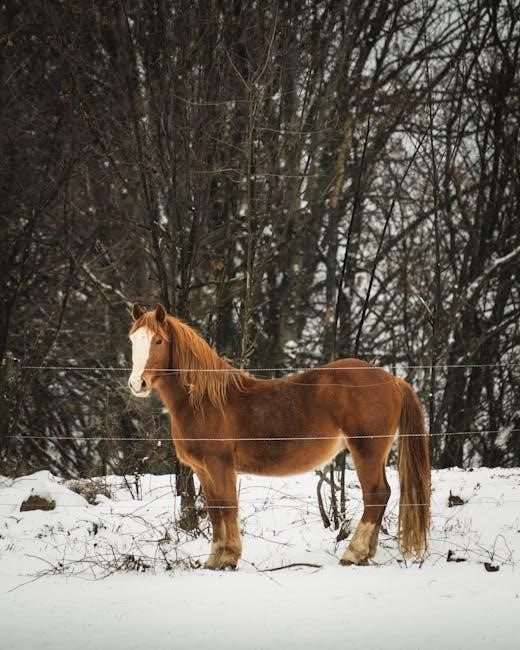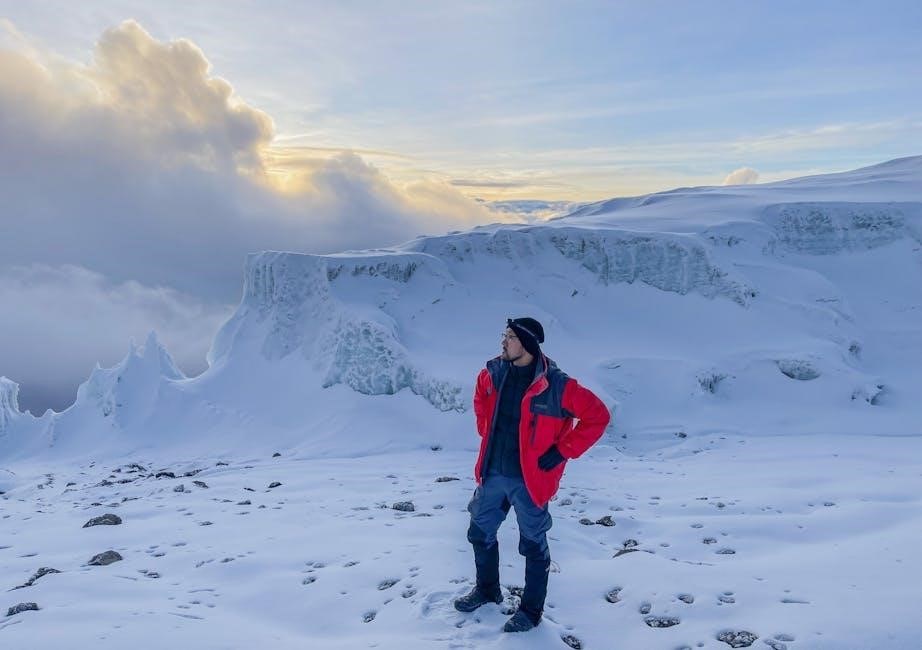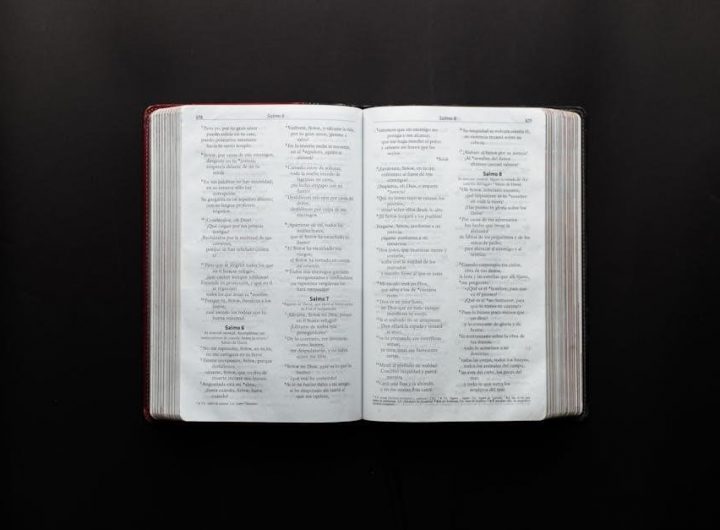
The Snows of Kilimanjaro, a renowned short story by Ernest Hemingway, explores themes of regret, love, and mortality. This article provides an in-depth analysis of the story.
1.1 Overview of the Story
The Snows of Kilimanjaro by Ernest Hemingway revolves around Harry, a writer dying of gangrene in Africa, reflecting on his life with his partner, Helen. As Harry faces mortality, he regrets unfulfilled ambitions and lost opportunities, particularly his failure to write meaningfully. The story intertwines Harry’s present struggles with fragmented memories of his past, revealing his complex relationship with Helen and his own self-criticism. The leopard atop Kilimanjaro symbolizes regret and unattained goals, while the hyena embodies decay and inevitability. Hemingway masterfully blends realism with symbolism, creating a poignant exploration of love, regret, and the search for meaning in life’s final moments.
1.2 Importance of the PDF Version
The PDF version of The Snows of Kilimanjaro offers unparalleled accessibility and convenience for readers. It ensures that Hemingway’s timeless narrative remains widely available, especially for students, researchers, and literature enthusiasts. The PDF format preserves the story’s original formatting, making it ideal for academic analysis and close reading. Additionally, it allows readers to access the text offline, enabling uninterrupted engagement with the story. The portability and ease of sharing the PDF version make it a valuable resource for educational purposes and personal study. This format ensures that Hemingway’s profound exploration of human emotions and existential themes reaches a broader audience, fostering deeper understanding and appreciation of his work.
1.3 Objective of the Article
The primary objective of this article is to provide a comprehensive analysis of Ernest Hemingway’s The Snows of Kilimanjaro. By examining the story’s themes, characters, and symbolic elements, the article aims to enhance readers’ understanding of Hemingway’s literary mastery. It also highlights the significance of the PDF version, emphasizing its accessibility and educational value. The article serves as a resource for students, scholars, and enthusiasts, offering insights into the story’s depth and complexity. By exploring the narrative’s layers, the article seeks to illuminate why The Snows of Kilimanjaro remains a pivotal work in modern literature, warranting continued exploration and appreciation.

Plot Summary
The story revolves around Harry, a writer on safari, who reflects on his life as he faces death. His regrets over unfulfilled ambitions and lost love dominate the narrative.
2.1 Setting and Background
The story is set in the African savannah, near Mount Kilimanjaro, during the colonial period. The vast, arid landscape creates a sense of isolation and impending death. Harry, a writer, lies ill with gangrene, while his companion Helen tends to him. The setting juxtaposes the majestic beauty of the mountain with the desolation of the plains, mirroring Harry’s internal struggle. The approaching death and the eerie presence of a hyena add tension. The background revolves around Harry’s reflections on his unfulfilled life, lost loves, and unfinished writing, highlighting themes of regret and mortality. The environment serves as a backdrop for Harry’s emotional and psychological journey.
2.2 Main Characters and Their Roles
The main characters in The Snows of Kilimanjaro are Harry, a writer suffering from gangrene, and Helen, his devoted companion. Harry, reflecting on his life, regrets unfulfilled ambitions and lost loves, often expressing bitterness towards Helen. Helen, loyal yet melancholic, tries to comfort Harry, coping with her own fears of losing him. The leopard, a symbolic presence, represents Harry’s unfinished aspirations and the elusiveness of his dreams. These characters drive the narrative, exploring themes of mortality, regret, and redemption through their interactions and internal struggles.
2.3 Key Events and Turning Points
The story begins with Harry, a writer, and Helen camping at the base of Mount Kilimanjaro. Harry’s leg infection escalates, leading to gangrene, and he reflects on his past. A pivotal moment occurs when Harry and Helen argue, revealing his bitterness and regret over unfulfilled ambitions. The leopard on the mountain symbolizes Harry’s elusive goals. His memories of past loves and missed opportunities highlight his regret. As Harry faces death, he requests to be buried beneath the leopard, symbolizing his acceptance of life’s unattained dreams. These events and symbols drive the narrative, emphasizing themes of mortality, regret, and redemption.

Themes
The story explores themes of regret, love, and the search for meaning, intertwined with Harry’s journey, reflecting on past choices and the pursuit of fulfillment.
3.1 Regret and Mortality
Regret and mortality are central to Harry’s narrative. Facing death, he reflects on unfulfilled ambitions and missed opportunities, revealing a life overshadowed by choices not taken. His memories, tinged with remorse, highlight the human tendency to postpone dreams until it’s too late. Hemingway masterfully weaves Harry’s internal conflict, illustrating how regret can define a life. The proximity of death intensifies Harry’s emotional reckoning, emphasizing the importance of living fully and authentically. This theme resonates universally, urging readers to confront their own regrets and cherish life’s fleeting moments.
3.2 Love and Redemption
Love and redemption emerge through Harry’s relationship with Helen, who embodies unwavering devotion despite his bitterness. Her presence prompts Harry to confront his past, seeking forgiveness and reconciliation. This dynamic underscores the redemptive power of love, offering Harry a path to inner peace. Helen’s loyalty and compassion contrast with Harry’s regret, highlighting the possibility of redemption through human connection. Their bond serves as a catalyst for Harry’s introspection, emphasizing the transformative impact of love in the face of mortality and personal failings.
3.3 The Search for Meaning
Harry’s journey in The Snows of Kilimanjaro is deeply intertwined with his search for meaning, driven by the weight of unfulfilled potential and looming mortality. His introspection reveals a man grappling with the choices of his past, seeking redemption through self-reflection. The snow-capped mountain symbolizes the elusive nature of meaning, representing both aspiration and the inevitability of death. Harry’s memories and interactions with Helen underscore his longing for connection and purpose, highlighting the human quest for significance in a finite existence. This theme resonates universally, inviting readers to ponder their own paths and the legacy they wish to leave behind.

Character Analysis
The story delves into the complexities of its characters, exploring their emotional depths and relationships. Harry, the protagonist, grapples with regret and mortality, while Helen embodies unwavering support. The leopard symbolizes existential struggles, adding depth to the narrative.
4.1 Harry: The Protagonist
Harry, the central character, is a complex figure grappling with his mortality and past regrets. As a writer, he reflects on his unfulfilled potential, revealing a deep sense of disillusionment. His relationship with Helen is marked by tension and introspection, as he struggles to reconcile his love for her with his own self-destructive tendencies. Harry’s journey is both physical and emotional, as he confronts the choices that have shaped his life. Hemingway portrays him as a flawed yet sympathetic character, whose internal battles resonate with universal human experiences. Through Harry, the story explores themes of regret, redemption, and the search for meaning.
4.2 Helen: The Supporting Character
Helen is a pivotal supporting character, offering emotional support and care to Harry as he confronts his mortality. Her nurturing nature contrasts with Harry’s bitterness, showcasing her unwavering dedication. Despite Harry’s emotional distance, Helen remains loyal, attempting to bridge the gap between them. Her character serves as a foil to Harry’s regret and introspection, highlighting his internal struggles. Through her interactions, Helen embodies compassion and resilience, providing a stark contrast to Harry’s self-destructive tendencies. Her presence underscores themes of love and redemption, emphasizing the human capacity for connection even in the face of despair. Helen’s role is integral to the story’s emotional depth.
4.3 The Leopard: Symbolic Representation
The leopard in The Snows of Kilimanjaro serves as a mysterious and symbolic element, often interpreted as a representation of divine or elusive truth. Its presence on the snow-capped mountain evokes themes of wonder and the unattainable. The leopard’s grace and solitude mirror Harry’s internal longing for transcendence and meaning. This enigmatic creature symbolizes the search for something greater, reflecting humanity’s eternal quest for answers to life’s profound questions. The leopard’s imagery enriches the story’s philosophical undertones, linking it to the broader themes of existence and the pursuit of fulfillment. Its symbolism adds depth to the narrative, inviting readers to ponder its significance.

Symbolism
Symbolism in The Snows of Kilimanjaro is profound, with the snow-capped mountain embodying unreachable aspirations and the hyena symbolizing death and decay, contrasting purity with corruption.
5.1 The Snows of Kilimanjaro
The snows of Kilimanjaro symbolize Harry’s unfulfilled aspirations and the transience of life. The mountain, with its snowy peak, represents distant dreams and the inevitability of mortality. Harry’s regret over missed opportunities is mirrored in the snow’s purity and inaccessibility, emphasizing his longing for redemption. The leopard at the summit, a mysterious figure, adds to the enigma, suggesting that even the most elusive goals remain unattainable. Through this imagery, Hemingway underscores the human struggle with regret, love, and the search for meaning, leaving readers to ponder the significance of unfulfilled desires and the fleeting nature of existence.
5.2 The Hyena and Its Significance
The hyena in The Snows of Kilimanjaro serves as a potent symbol of decay and inevitability; Its presence underscores the natural cycle of life and death, as it scavenges for flesh, representing the irreversible fate that awaits all living beings. The hyena’s laughter-like calls echo the absurdity and cruelty of nature, highlighting Harry’s mortality and his inability to escape the consequences of his choices. This creature, often associated with cowardice and opportunism, contrasts sharply with the leopard, symbolizing Harry’s unfulfilled aspirations. Together, they encapsulate Hemingway’s exploration of regret, redemption, and the universal human struggle with impermanence.

Writing Style
Hemingway’s concise, direct prose in The Snows of Kilimanjaro reflects his distinctive style, emphasizing simplicity and clarity while conveying deep emotional complexity through subtle dialogue and narrative structure.
6.1 Hemingway’s Iceberg Theory
Hemingway’s Iceberg Theory is evident in The Snows of Kilimanjaro, where most of the story’s depth lies beneath the surface. The narrative subtly implies themes like regret, love, and mortality through understatement and sparse details. Hemingway’s minimalist approach forces readers to infer much from little, making the story rich and layered. This technique enhances emotional resonance, as the unsaid often carries more weight than the explicit. The theory’s effectiveness is particularly clear in Harry’s introspections and the sparse dialogue, allowing the story’s complexity to emerge gradually. This style not only reflects Hemingway’s literary philosophy but also underscores the story’s enduring impact.
6.2 Use of Dialogue and Narrative Structure
In The Snows of Kilimanjaro, Hemingway employs sparse yet impactful dialogue to reveal character dynamics and emotional depth. Conversations between Harry and Helen are minimalistic, reflecting Hemingway’s belief in subtlety. The narrative structure is non-linear, blending Harry’s present struggles with flashbacks of his past, creating a layered exploration of regret and lost opportunities. This structure mirrors the Iceberg Theory, as much of the story’s meaning lies beneath the surface. The dialogue and narrative flow work together to build tension and highlight the protagonist’s introspective journey, making the story both poignant and thought-provoking.

Historical Context
The story is set against the backdrop of colonialism in 1930s Africa, reflecting Hemingway’s personal experiences as a big-game hunter and the societal changes of the time.
7.1 The Time Period of the Story
The story is set in the 1930s, during the height of colonialism in Africa. It reflects the societal changes and cultural shifts of the time, including the decline of colonial empires and the rise of modernity. Hemingway’s experiences as a big-game hunter in Africa during the 1930s heavily influenced the narrative, blending personal insights with fictional elements. The time period also highlights themes of exploration and the clash between tradition and progress, which were prevalent during this era. The story captures the essence of a bygone age, offering a glimpse into the lives of those navigating a rapidly changing world.
7.2 Hemingway’s Personal Influences
Ernest Hemingway’s personal experiences deeply shaped The Snows of Kilimanjaro. His time as a journalist and big-game hunter in Africa influenced the story’s setting and themes. Hemingway’s relationships, including his marriage to Pauline Pfeiffer, inspired the dynamic between Harry and Helen. Additionally, his struggles with health and mortality, reflected in Harry’s physical decline, added a layer of autobiographical depth. Hemingway’s minimalist writing style, honed during his early career, is evident in the story’s concise yet powerful narrative. These personal influences enriched the tale, blending fiction with real-life emotions and experiences, creating a timeless exploration of human regret and redemption.

The PDF Version
The PDF version of The Snows of Kilimanjaro offers a convenient and accessible way to read Hemingway’s timeless story, preserving its original depth and emotional impact.
8.1 Availability and Accessibility
The PDF version of The Snows of Kilimanjaro is widely available online, accessible through various digital platforms, including e-book retailers, academic databases, and literary websites. Readers can easily download or access it on multiple devices, ensuring convenience and portability. Additionally, the PDF format supports features like text search, zoom, and bookmarking, enhancing readability and study. Its availability on popular platforms makes it accessible to a global audience, catering to both casual readers and scholars. This format also allows for easy sharing and reference, making it a preferred choice for educational purposes and personal reading experiences.
8.2 Benefits of Reading the PDF
Reading The Snows of Kilimanjaro in PDF format offers several advantages. The portability of the file allows readers to access the story on multiple devices, ensuring convenience and flexibility. The PDF preserves the original formatting, maintaining the integrity of Hemingway’s writing style. Additionally, features like text search, bookmarking, and zoom enable easier navigation and study. The ability to highlight and annotate text aids in deeper analysis. Furthermore, the PDF version reduces the need for physical copies, making it an environmentally friendly option. Its availability in digital format also ensures accessibility for readers worldwide, fostering a broader engagement with Hemingway’s work.

Study Questions
- How does Harry’s regret shape his character development in the story?
- What role does love play in Harry’s journey toward redemption?
- How do the leopard and hyena symbolize broader themes?
9.1 Understanding the Protagonist’s Motivations
Harry, the protagonist, is driven by a complex mix of regret, unfulfilled ambition, and the pursuit of redemption. His motivation stems from a lifetime of missed opportunities, particularly in his writing career, which he feels has been squandered. The presence of Helen, who embodies love and devotion, further complicates his internal struggles, as he grapples with the fear of losing her. Harry’s desire to write the “perfect” story, symbolized by the leopard on Mount Kilimanjaro, reflects his longing to leave a lasting legacy. His motivations are deeply intertwined with his mortality, as he seeks to reconcile his past failures with his final moments.
9.2 Analyzing the Theme of Regret
Regret is a central theme in The Snows of Kilimanjaro, as Harry reflects on his life, filled with unfulfilled ambitions and missed opportunities. His regret is deeply tied to his writing career, which he feels he has squandered, and his relationship with Helen, whom he believes he has emotionally neglected. Hemingway portrays regret as a double-edged sword, fueling both self-pity and self-awareness. Harry’s regret is not just about what he has done, but also about what he has failed to do, symbolized by the unwritten stories and the leopard on Kilimanjaro. This theme underscores the human condition’s struggle with mortality and the longing for redemption.
9.3 Exploring the Symbolism of the Mountain
The mountain in The Snows of Kilimanjaro is a profound symbol, representing both eternity and the unattainable. Its snow-capped peak embodies purity and transcendence, yet remains distant and inaccessible. The leopard on the mountain symbolizes the pursuit of perfection and the futility of human endeavor. For Harry, the mountain serves as a constant reminder of his unfulfilled aspirations, reflecting his internal struggle with regret and mortality. The mountain’s enduring presence contrasts with the transience of human life, underscoring the theme of missed opportunities. Ultimately, the mountain acts as a mirror to Harry’s soul, symbolizing his longing for redemption and the elusive nature of perfection.
The story masterfully explores themes of regret, mortality, and the search for meaning, showcasing Hemingway’s distinctive narrative style. The PDF version enhances accessibility, preserving its timeless impact.
10.1 Recap of Key Points
The story delves into themes of regret, mortality, and redemption through Harry’s reflections. His relationship with Helen and the leopard’s symbolism highlight his internal struggles. Hemingway’s concise style, emphasizing dialogue and narrative structure, underscores the emotional depth. The PDF version enhances accessibility, making the story’s poignant exploration of human frailty and the search for meaning readily available for modern readers. This format preserves the original’s impact while offering a convenient way to engage with Hemingway’s profound work.
10.2 Final Thoughts on the Story’s Impact
The Snows of Kilimanjaro leaves a profound impact, inviting readers to reflect on life’s fleeting nature and unfulfilled aspirations. Harry’s journey mirrors universal human struggles, evoking empathy and introspection. The story’s emotional depth, combined with Hemingway’s minimalist style, creates a lasting impression. Its exploration of regret, love, and the search for meaning resonates deeply, encouraging readers to evaluate their own lives. The PDF version ensures this timeless tale remains accessible, preserving its ability to inspire and challenge future generations. Hemingway’s masterpiece continues to be a powerful reminder of life’s fragility and the importance of seeking redemption.

References
- Hemingway, E. (1936). The Snows of Kilimanjaro.
- Academic critiques and analyses of the short story.
- Online sources providing in-depth interpretations.
11.1 Sources for Further Reading
For deeper exploration, readers can access academic articles analyzing Hemingway’s narrative techniques and thematic elements. Literary critiques and study guides offer insights into the story’s symbolism and character development. Additionally, online databases like JSTOR and Google Scholar provide access to scholarly essays. Libraries and e-book platforms feature collections of Hemingway’s works, including The Snows of Kilimanjaro. These resources enhance understanding of the story’s historical context and emotional depth, making them invaluable for students and enthusiasts alike. They also highlight Hemingway’s unique writing style and its impact on modern literature.
11.2 Academic Critiques and Analyses
Scholars have extensively analyzed The Snows of Kilimanjaro, praising its profound exploration of human emotions and existential themes. Critics highlight Hemingway’s minimalist style, which subtly conveys deep psychological complexity. Academic essays often focus on the symbolism of the snow-capped mountain and its representation of unfulfilled aspirations. The dynamic between Harry and Helen has also been a subject of discourse, with many interpreting it as a reflection of Hemingway’s personal experiences. Additionally, analyses explore the story’s use of flashback sequences and their role in building narrative depth. These critiques provide valuable insights into the story’s layered meanings and its enduring impact on literary studies.
 citi program quiz answers pdf
citi program quiz answers pdf  upper back stretches pdf
upper back stretches pdf  esthetician exam study guide pdf
esthetician exam study guide pdf  solomon book of wisdom pdf
solomon book of wisdom pdf  imagine john lennon sheet music piano pdf
imagine john lennon sheet music piano pdf  contractor certificate of completion pdf
contractor certificate of completion pdf  dsc impassa user guide
dsc impassa user guide  2023 hyundai santa fe manual
2023 hyundai santa fe manual